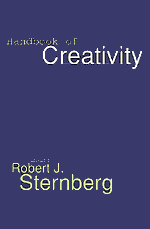Book contents
- Frontmatter
- Contents
- List of Contributors
- Preface
- Handbook of Creativity
- PART I INTRODUCTION
- PART II METHODS FOR STUDYING CREATIVITY
- 3 Psychometric Approaches to the Study of Human Creativity
- 4 Experimental Studies of Creativity
- 5 The Case Study Method and Evolving Systems Approach for Understanding Unique Creative People at Work
- 6 Creativity from a Historiometric Perspective
- PART III ORIGINS OF CREATIVITY
- PART IV CREATIVITY, THE SELF, AND THE ENVIRONMENT
- PART V SPECIAL TOPICS IN CREATIVITY
- PART VI CONCLUSION
- Author Index
- Subject Index
6 - Creativity from a Historiometric Perspective
Published online by Cambridge University Press: 05 June 2014
- Frontmatter
- Contents
- List of Contributors
- Preface
- Handbook of Creativity
- PART I INTRODUCTION
- PART II METHODS FOR STUDYING CREATIVITY
- 3 Psychometric Approaches to the Study of Human Creativity
- 4 Experimental Studies of Creativity
- 5 The Case Study Method and Evolving Systems Approach for Understanding Unique Creative People at Work
- 6 Creativity from a Historiometric Perspective
- PART III ORIGINS OF CREATIVITY
- PART IV CREATIVITY, THE SELF, AND THE ENVIRONMENT
- PART V SPECIAL TOPICS IN CREATIVITY
- PART VI CONCLUSION
- Author Index
- Subject Index
Summary
What is creativity? How can creativity be measured? What factors predict the appearance or demonstration of creativity? How can the psychologist even begin to tackle these questions? Let us begin with the last issue, for on that response depends the answer to the more fundamental issues. For some time psychologists have had three major methods at their disposal.
First, psychologists can design and execute laboratory experiments. Here creativity is usually defined as the successful solution of problems that require some degree of insight (see, e.g., Sternberg & Davidson, 1995). Less commonly the production of original ideas is required, the creativity then being assessed by some panel of judges or other means (see, e.g., Amabile, 1996; Martindale, 1973; Sternberg & Lubart, 1995). By carefully manipulating the situation in which this behavior takes place, psychologists can learn the conditions that most favor creativity. The “subjects” (or participants) in these experiments are most often college students who need to earn extra credit in an introductory psychology course, although occasionally the subjects are individuals who might actually call themselves “creative” without too much immodesty.
- Type
- Chapter
- Information
- Handbook of Creativity , pp. 116 - 134Publisher: Cambridge University PressPrint publication year: 1998
- 14
- Cited by



